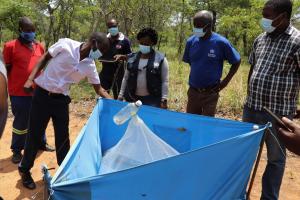Zimbabwe revives sleeping sickness case detection and management
By Tatenda Chimbwanda
Kariba, Zimbabwe: Human African trypanosomiasis (HAT) also known as sleeping sickness is a vector-borne disease transmitted to humans by tsetse fly bites, which have acquired their infection from human beings or animals. Over the years the country has made great progress in eliminating tsetse flies with areas such as Gokwe being declared free of the vector, which causes sleeping sickness. However, sleeping sickness transmission in humans is still taking place with several cases being reported in the country. For instance, the last case of sleeping sickness was recorded in 2019 yet some areas in the country with a high malaria burden also have a high prevalence of sleeping sickness. These cases of sleeping sickness are being recorded mainly amongst tourists and other people visiting national game parks. Most of these are being diagnosed and managed outside the country but being traced back to Zimbabwe. This has been mainly due to poor case detection and management of sleeping sickness in the country caused by limited capacity and awareness among health care workers to diagnose sleeping sickness.
“As a country not much activity was being done with regards to sleeping sickness. One of the key issues we discovered was the low suspicion index, which is why we had to respond by developing standard case definition and surveillance explained,” Sidney Danda, MoHCC National Vector Control Officer.
In response to the late case detection and poor surveillance, the Ministry of Health and Child Care (MoHCC) with support from WHO conducted training of health care workers targeting the affected areas in 2019. The training was followed by support and supervision visits in 2020 and 2021 to understand why few cases of sleeping sickness were being recorded. The visits also aimed at providing onsite training on detection and treatment of sleeping sickness in hot spot areas in Mashonaland West and Mashonaland Central.
The findings from the initial support and supervision highlighted the gaps which were discovered in sleeping sickness case detection and management in Zimbabwe. This led to MoHCC with support from The University of Zimbabwe and WHO to develop; standard case definition of sleeping sickness in Zimbabwe which did not exist before.
In addition, the MoHCC with WHO technical and financial support also developed on job aids on how to detect and manage sleeping sickness. Laboratory algorithms on how to collect and analyze blood samples for sleeping sickness and tools to capture sleeping sickness cases into the District Health Information System (DHSI2) in order to ensure early detection of sleeping sickness. The tools were mainly based on the WHO generic tools adapted to the local context.
“Under the Neglected Tropical Diseases (NTDs) program, WHO has been providing technical assistance to Zimbabwe's national HAT control programme including supply of medicines for sleeping sickness to hot spots as well as support to vector control activities,” says Dr Anderson Chimusoro, WHO Zimbabwe NTDs focal point.
As a result, the MoHCC tools for sleeping sickness surveillance and management will improve diagnosis and treatment of sleeping sickness in hot spot areas. The supportive supervision increased health workers awareness of sleeping sickness as a disease of public health importance. Furthermore, health workers are now aware of the overlap in symptoms between malaria and sleeping sickness.
Given the fluidity of health workers, particularly attrition of laboratory personnel, MoHCC is working on refresher training of health workers on case detection of sleeping sickness to enable them to suspect and screen for sleeping sickness infection as well as train laboratory personale to be able to detect Trypanosoma parasites in blood samples. This will be supported by distributing the tools which were developed to aid in the detection and treatment of sleeping sickness to the hot spots together with appropriate sensitization on their use. Surveillance will also be strengthened to capture and report sleeping sickness data to the next level of reporting as well as monitoring the availability, use and lifespan of medicines supplied.
